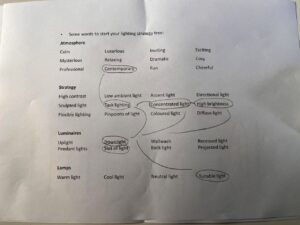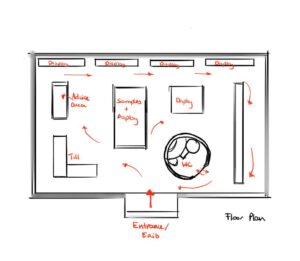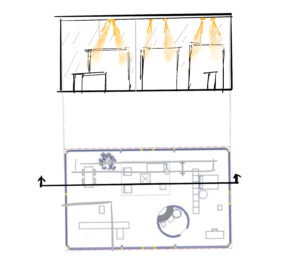Week 06 – Workshop Reflection – Lighting Strategies

This week’s class was a workshop on Lighting Strategies, where we analysed the function of different spaces and learned how to use light to create atmosphere, direct flow and enhance the emotional expression of the space. The type of space that my group and I were given was a “Paint Store”, and the venue was set in Philip Johnson’s Glass House, an iconic modernist building.

Based on the “Lighting Strategy Tree” provided by the teacher, we selected keywords from the tree to create a lighting scheme that balanced functionality and mood. The finalised keywords include:
– Atmosphere: Contemporary
– Strategy: Low ambient light, Task lighting, Concentrated light, High brightness, Diffuse light.
– Luminaires: Downlight, Slot of light
– Lamps: Tunable light.
Why did we choose this lighting strategy?
As a paint shop, we see light not only as a functional requirement, but also as a presentation medium. Paint itself is an expression of colour, and the perception of colour is strongly influenced by the colour temperature and brightness of different light sources. Therefore, we put forward the following core demands:
1, real colour reproduction: choose adjustable light source (Tunable light), can simulate cold light, warm light, neutral light and other different daily situations, so that customers can experience the visual effect of paint in different lighting.
2、 Emphasis on functional areas: Task lighting and Concentrated light are used in the sample display wall and colour mixing trial area to ensure accurate and clear colour performance.
3、 Create a sense of hierarchy: the overall space is based on low ambient light, and the visual rhythm is built through key lighting and high-brightness areas, which strengthens the spatial orientation and focus distribution.
4, space clean and pure: the choice of downlights (Downlight) and light groove (Slot of light), hiding the body of the lamps and lanterns, to keep the ceiling surface simple, and Philip Johnson’s modernist context echo.
Secondly, in the course of our discussion, we also wondered whether this could also be a dialogue between light and the glasshouse. Placing the paint shop in a glass house is a reflection on the relationship between “transparency” and “spatial definition”. As the glasshouse space is almost borderless, our lighting strategy plays an important role in delineating the space and guiding the view. Through the directionality of light and the contrast of luminance, we have achieved a balance between functional zoning and emotional change in an “open and unified” spatial shell. 







